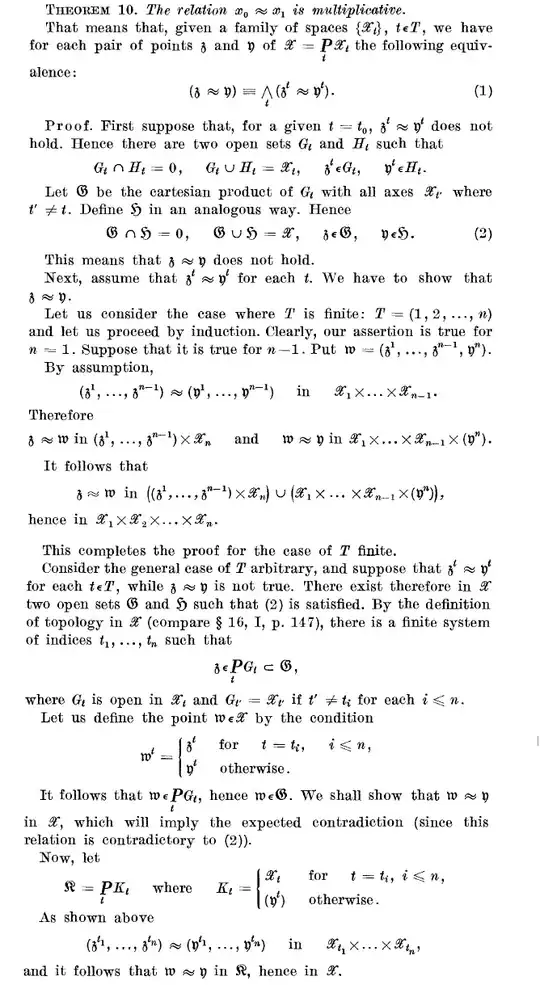Definition
The quasi-component $Q_x$ of $x\in X$ is the intersection of the clopen set that contains $x$.
Observation
Since the intersection (infinite as well) of closed sets is always closed, any quasi-component is a closed set.
Lemma
The quasi-components of two distinct points of a topological space $X$ either coincide or are disjoint, so that all quasi-components constitute a decomposition of the space $X$ into pairwise disjoint closed subsets.
Proof. So if $y\in Q_x$ for some $x,y\in Q_x$ then clearly $Q_y\subseteq Q_x$ and so this means that if $Q$ is clopen and $x\in Q$ then $y\in Q$. So now we suppose that $Q_y\subset Q_x$, that is there exist a clopen set $Q$ such that $Q\subseteq X\setminus\{x\}$ and so $X\setminus Q$ is a clopen such that $x\in X\setminus Q$ and so $y\in X\setminus Q$, but this would mean that $Q\cap X\setminus Q\neq\varnothing$ and clearly this is impossible.
Corollary
For any topological space $X$ the relation $$ x\approx y\iff Q_x=Q_y $$ for any $x,y\in X$ is an equivalence relation in $X$.
Corollary
For any topological space $X$ and for any $x,y\in X$ it follows that $x\approx y$ iff for any binary open partition of $X$ it follows that $x$ and $y$ belong to the same part.
Proof. If $x\approx y$ clearly then if there exist a binary partition of $X$ such that $x$ and $y$ don't belong to the same part then there exist two disjoint open set $U$ and $V$ such that $x\in U$ and $y\in V$ and $U\cap V=\varnothing$; but if this was happen then $U$ and $V$ are two clopen set such that $x\in U$ and $y\in V$ and $x\notin V$ and $y\notin U$ and this would be inconsistence respect to the assumption $x\approx y$. Now we observe that if $Q\subseteq X$ is clopen then $Q$ and $X\setminus Q$ induce a open partition on $X$. So if $x,y\in X$ are such that for any binary partition of $X$ it follows that $x$ and $y$ belong to the same part then if $Q$ is a clopen set and $x\in Q$ then $y\in Q$ and so clearly $Q_x=Q_y$.
Now what shown below is a theorem of "Topology II" by Kazimierz Kuratowski
So I don't understand the point $2$ of the proof and so to explain it I proved the second corollary: so is its proof correct? then using it could I explain the point 2? Then I don't understand why $\mathfrak{z\approx m}\in(\mathfrak{z^1,...,z^n})\times\mathscr{X}_n$ and $\mathfrak{m\approx y}\in\mathscr{X_1\times...\times X_n}\times\mathfrak{y}^n$. Then why $\mathfrak{z\approx m}\in\Big((\mathfrak{z^1,...,z}^{(n-1)})\times\mathscr{X_n}\Big)\cup\Big(\mathscr{X_1\times...\times X}_{n-1}\times(\mathfrak{y}^n)\Big)$ and so why $\mathfrak{z\approx m}$ in $\mathscr{X_1\times...\times X}_n$? So if this is true why $\mathfrak{z\approx y}$ in $\mathscr{X_1\times...\times X}_n$? Finally why if $(\mathfrak{z}^{t_1},...\mathfrak{z}^{t_n})\approx(\mathfrak{y}^{t_1},...,\mathfrak{y}^{t_n})$ in $\mathscr{X_{t_1}\times....\times X_{t_n}}$ then $\mathfrak{m\approx y}$ in $\mathscr{R}$ and so then why in $\mathscr{X}$?
So could someone help me, please?
